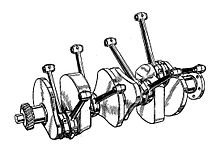Crossplane
A specific type of crankshaft for reciprocating piston engines is called a crossplane or cross-plane . The crossplane crankshaft is the most commonly used type in V8 engines . In these engines, the connecting rods of two opposing cylinders of a V share a common crank pin .
With crossplane crankshafts, the angle between adjacent crankpins - the crankpin offset - is 90 ° or 270 ° instead of 180 °. Viewed axially, the two planes of the respective crank pins are 90 ° crossed to one another, hence the name crossplane ("crossed plane"). In the case of crankshafts with four crankshafts and a relative offset of 0 ° -180 ° -180 ° -0 ° - as with a conventional in-line four-cylinder crankshaft - there is only a single plane in this axial view, which is called a flat plane .
Eight cylinder V engines
Firing orders
In eight-cylinder V four-stroke engines with a 90 ° cylinder bank angle, both types (crossplane or flatplane) have an even spacing of the working cycles (ignitions) of 90 ° crank angle each (eight cylinders = eight cycles during 720 ° crankshaft rotation). While with flatplane engines, one cylinder of the left and right cylinder bank ignites alternately one after the other due to the firing sequence specified by the crank kinematics (example: typical firing sequence - according to the American numbering scheme: 1-4-3-2-7-6-5 -8, side distribution thus LRLRLRLR) with crossplane engines there is inevitably a firing sequence in which two cylinders (example: firing sequence 1-8-4-3-6-5-7-2, side distribution thus LRRLRLLR) of the same occur once for each revolution Cylinder banks execute one work cycle one after the other. In the case of the crossplane engine, this peculiarity causes a characteristic running noise ("bubbling"), which usually occurs with large-volume US automobiles, due to the alternately stronger pulsing pressure in the left and right flow of the exhaust system (due to the double, immediately successive exposure to exhaust gas) Is associated. In high-performance engines with twin-pipe exhaust systems, the middle cylinders of one bank are combined with the outer cylinders of the other bank. Because of the winding pipe routing, these exhaust systems are also called "snake nests".
Mass balancing
In V8 engines with flat-plane crankshafts, the first-order inertia forces and moments balance each other out within each cylinder bank, since, as with the four-cylinder in-line engine, the two inner and two outer pistons move symmetrically upwards or downwards in opposite directions. The geometrically determined different accelerations caused by the piston moving up or down cause free forces of the second order. As with the inline four-cylinder, they do not balance each other out.
With the Crossplane V8, a first-order free mass moment is created by the unevenly offset movement of the pistons per cylinder bank, but this moment can be well balanced by large counterweights on the front and rear crank webs . The middle crank webs get along with smaller counterweights due to the leverage. Second-order inertial forces balance each other out well in the crossplane engine, as they occur offset due to the asymmetrical piston movement.
Thus, the crossplane engine runs relatively smoothly, but at the price of a bulky and heavy crankshaft due to the counterweights, which requires a lot of space in the crankcase and, due to its high inertia, can be accelerated or decelerated more slowly in rotation. On the other hand, this simple balancing, just with rotating counterweights on the crankshaft without additional balancing shafts , sets few limits with regard to the dimensions and masses of the oscillating components in the engine, so that large-volume, comparatively slow-running engines can be built here (example: Cadillac 500 CID , 500 cui = approx. 8.2 liter cubic capacity, approx. 400 SAE-PS at 4400 min −1 , 1970, at that time a serial car engine with the largest cubic capacity). Crossplane motors are mainly known as typical drives for US “ road cruisers ”.
With the flatplane V8, the uncompensated second-order inertia forces can only be counteracted by restricting them to smaller displacements and thus lighter pistons and connecting rods. For this, much lighter counterweights are required to compensate for the masses of the individual crank pins and connecting rods on the crank webs, which enables the construction of compact and powerful sports engines with a low center of gravity. Examples are the Ferrari 458 (all Ferrari V8s, beginning with the 308 , are flat plane engines), as well as the successful Formula 1 engine Cosworth DFV.
The Coventry Climax Formula 1 engine FWMV 1.5 l V8 was redesigned from cross plane to flat plane during the course of its development and with it, Jim Clark won the world championship title in 1963 in the Lotus 25 and in 1965 in the Lotus 33 .
Four-cylinder in-line engines
Crossplane crankshafts are also used in some inline four-cylinder engines in motorcycles . Examples are the Yamaha YZF-R1 from 2009, the MotoGP racing machine Yamaha YZR-M1 , the Yamaha MT-10 and MT-07 or the historic Fath-URS sidecar engine by Helmut Fath and Peter Kuhn .
Web links
- Animation of crossplane and flatplane crankshafts in the V eight-cylinder engine
- Animation of crossplane and flatplane crankshafts in an in-line four-cylinder engine
- Yamaha archive article on the crossplane crankshaft
Individual evidence
- ↑ The V8 engine - home of bubbling , article on Heise.de about the V eight-cylinder engine, page 4 , accessed on May 15, 2016.
- ↑ https://www.youtube.com/watch?v=ieSfxt_yMUQ
- ↑ Article on the various designs of V8 engines on Craig's website , English, accessed May 14, 2015.
- ^ Coventry Climax FWM engine , English, accessed May 15, 2015.
- ↑ Development history of the URS racing engine , accessed on May 14, 2016.


